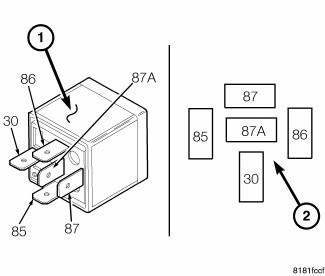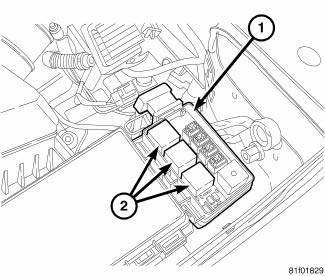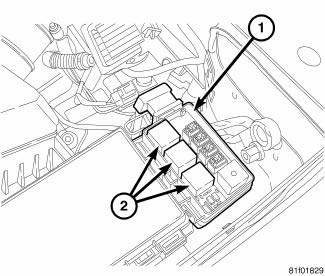Dodge Journey: Relay, heater unit
DESCRIPTION

Fig. 320: Standard ISO-Type Relay
Three relays (1) are used for the electric positive temperature coefficient (PTC) heater system when equipped with the 2.0L diesel engine. The relays are International Standards Organization (ISO)-type relays. Relays conforming to the ISO specifications have common physical dimensions, current capacities, terminal functions and patterns (2). The PTC relays are electromechanical devices that switch fused battery current directly to the heating elements of the PTC heater unit. The PTC relays are energized by control circuits of the totally integrated power module (TIPM).
The three PTC relays are located in the diesel accessory fuse/relay block in the engine compartment.
OPERATION
The three ISO-standard relays (1) used for the electric positive temperature coefficient (PTC) heater system are electromechanical switches that use a low current ASD power input to control the high current fused battery power output to the PTC heater unit. On each relay, the movable, common feed relay contact is held against the fixed, normally closed relay contact by spring pressure. When the electromagnetic relay coil is energized, it draws the movable common feed relay contact away from the fixed, normally closed relay contact and, holds it against the fixed, normally open relay contact. This action allows high current to flow to one or more of the heating elements of the PTC heater.
When the relay coil is de-energized, spring pressure returns the movable relay contact back against the fixed, normally closed contact point. The resistor or diode is connected in parallel with the relay coil, and helps to dissipate voltage spikes and electromagnetic interference that can be generated as the electromagnetic field of the relay coil collapses.
The terminals for the PTC relays are connected to the vehicle electrical system through receptacles in the diesel accessory fuse/relay block. The PTC relays cannot be repaired and must be replaced if inoperative or damaged. See SYSTEM WIRING DIAGRAMS for diagnosis and testing of the ISO-standard relays and for complete TIPM and HVAC wiring diagrams.
REMOVAL

Fig. 321: Diesel Accessory Fuse/Relay Block
NOTE: LHD model shown. RHD model similar.
1. Disconnect and isolate the negative battery cable.
2. Remove the cover from the diesel accessory fuse/relay block (1) located near the left front strut tower.
3. Remove the positive temperature coefficient (PTC) relays (2) as necessary from the fuse/relay block.
INSTALLATION

Fig. 322: Diesel Accessory Fuse/Relay Block
NOTE: LHD model shown. RHD model similar.
1. Position the positive temperature coefficient (PTC) relays (2) as necessary into the proper receptacle of the diesel accessory fuse/relay block (1) located near the left front strut tower
2. Align the PTC relay terminals with the terminal cavities in the fuse/relay block and push down firmly on each relay until the terminals are fully seated.
3. Install the cover onto the diesel accessory fuse/relay block.
4. Reconnect the negative battery cable.
 Cabin heater
Cabin heater
...
 Unit, heater
Unit, heater
DESCRIPTION
Fig. 323: Positive Temperature Coefficient Heater - Description
NOTE: LHD model shown. RHD model similar.
An electric positive temperature coefficient (PTC) heater unit (1) is us ...
See also:
Removal
Fig. 93: Accessory Drive Belt System - 2.7L
- GENERATOR
- IDLER/TENSIONER
1. Perform fuel pressure release procedure before attempting any repairs.
2. Disconnect negative cable from rem ...
Description
Four-wheel disc brakes are standard on this vehicle. Each disc brake assembly
consists of the following major
components:
Caliper
Caliper adapter bracket
Pads (Shoe and lining assemblies)
...
Insulator, engine mount, front
Removal
1. Raise vehicle.
Fig. 222: Belly Pan
- belly pan fasteners
- belly pan
2. Remove the belly pan (2).
Fig. 223: Front Engine Mount Through Bolt
3. Remove front mount to bracket ...
